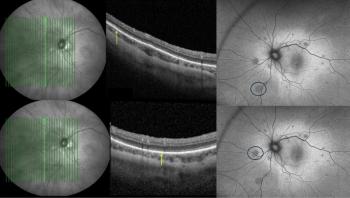
Prophylactic antibiotic use for intravitreal injections
In this article, the authors discuss preventative efforts related to retinal diseases that are made by ophthalmologists to avoid infections and how mounting data seems to be pointing at the discontinuation of peri-injection topical antibiotic drops.
In a recent report, well over 1 million intravitreal injections were performed in the US in 2010 alone with Europe likely having proportionally similar volumes.1 At these high volumes, even minimal increases in the rates of adverse events become an important issue for eye care providers and also for public health.
In an attempt to prevent infection, many ophthalmologists routinely employ prophylactic topical antibiotics as part of their peri-procedural protocol for intravitreal injections.
On the surface, this practice may seem like good medicine: use an effective, familiar, well-tolerated medication to reduce the risk of a rare but devastating infection. We have been taught to do this in other areas of ophthalmic surgery, so why not give our injection patients this extra protection?
Of course, few things in medicine are quite so simple. First, is the use of prophylactic topical antibiotics giving our patient any real benefit? Second, is this practice possibly causing harm? Third, what is the current medico legal issue surrounding this topic?
Pre-injection
It is well recognized that thorough preparation of the eye with povidone-iodine prior to injection is absolutely critical.2 Iodine is an extremely effective agent with near total bactericidal effectiveness by disrupting bacterial and viral cell walls. Currently, there is no known bacterial resistance to iodine. The mechanism of action of fluoroquinolones, one of the more commonly used topical antibiotics, is to inhibit bacterial DNA topoisomerase/DNA gyrase.
Povidone-iodine's kill time is between 15 and 120 seconds after contact,3 which is significantly shorter than the contact time provided by a typical injection prep. Moxifloxacin, however, failed to kill nearly all staphylococcal isolates at 60 minutes after application4 and may have a kill times as long as 4 hours,5 far too long for pre-injection application to have any effect.
These and other studies show that application of topical antibiotic drops directly before the injection provides no additional antibacterial protection beyond a povidoneiodine prep and is most likely not a beneficial tactic.
Post-injection
Some ophthalmologists apply a drop of antibiotic medication to they eye immediately after the injection or prescribe a course of several days for use after the procedure. With these one-time-applications or short courses of antibiotics come concerns about promoting antibiotic resistance to our best antibacterial weapons.
Several studies have shown that resistance to fluoroquinolones as much as doubled (from 32% to 63%) in patients who used post-injection topical antibiotics.6 Taking this one step further, as most postprocedural endophthalmitis comes from the patient's own eye flora, and use of post-injection antibiotics leads to increased resistance, then use of antibiotics may lead to more resistant organisms in these cases of endophthalmitis.
Likewise, one may plan to employ post-injection topical antibiotics in hopes of providing intraocular prophylaxis in the vitreous cavity rather than only acting at the conjunctiva. However, published data has shown vitreous penetration of topical fluoroquinolones is quite poor, making this strategy probably futile.
Newsletter
Get the essential updates shaping the future of pharma manufacturing and compliance—subscribe today to Pharmaceutical Technology and never miss a breakthrough.













































